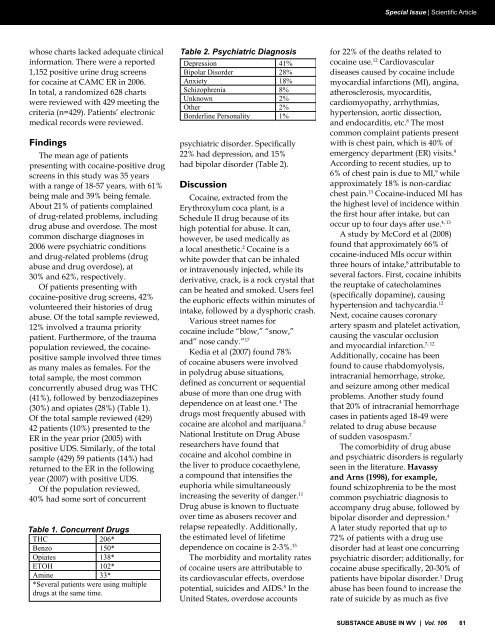Substance Abuse in WV - West Virginia State Medical Association
Substance Abuse in WV - West Virginia State Medical Association
Substance Abuse in WV - West Virginia State Medical Association
- No tags were found...
You also want an ePaper? Increase the reach of your titles
YUMPU automatically turns print PDFs into web optimized ePapers that Google loves.
Special Issue | Scientific ArticleTable 2able 1whose charts lacked adequate cl<strong>in</strong>ical<strong>in</strong>formation. There were a reported1,152 positive ur<strong>in</strong>e drug screensfor coca<strong>in</strong>e at CAMC ER <strong>in</strong> 2006.In total, a randomized 628 chartswere reviewed with 429 meet<strong>in</strong>g thecriteria (n=429). Patients’ electronicmedical records were reviewed.F<strong>in</strong>d<strong>in</strong>gsThe mean age of patientspresent<strong>in</strong>g with coca<strong>in</strong>e-positive drugscreens <strong>in</strong> this study was 35 yearswith a range of 18-57 years, with 61%be<strong>in</strong>g male and 39% be<strong>in</strong>g female.About 21% of patients compla<strong>in</strong>edof drug-related problems, <strong>in</strong>clud<strong>in</strong>gdrug abuse and overdose. The mostcommon discharge diagnoses <strong>in</strong>2006 were psychiatric conditionsand drug-related problems (drugabuse and drug overdose), at30% and 62%, respectively.Of patients present<strong>in</strong>g withcoca<strong>in</strong>e-positive drug screens, 42%volunteered their histories of drugabuse. Of the total sample reviewed,12% <strong>in</strong>volved a trauma prioritypatient. Furthermore, of the traumapopulation reviewed, the coca<strong>in</strong>epositivesample <strong>in</strong>volved three timesas many males as females. For thetotal sample, the most commonconcurrently abused drug was THC(41%), followed by benzodiazep<strong>in</strong>es(30%) and opiates (28%) (Table 1).Of the total sample reviewed (429)42 patients (10%) presented to theER <strong>in</strong> the year prior (2005) withpositive UDS. Similarly, of the totalsample (429) 59 patients (14%) hadreturned to the ER <strong>in</strong> the follow<strong>in</strong>gyear (2007) with positive UDS.Of the population reviewed,40% had some sort of concurrentTable 1. Concurrent DrugsTHC 206*Benzo 150*Opiates 138*ETOH 102*Am<strong>in</strong>e 33**Several patients were us<strong>in</strong>g multipledrugs at the same time.Table 2. Psychiatric Diagnosis DiagnosisDepression 41%Bipolar Disorder 28%Anxiety 18%Schizophrenia 8%Unknown 2%Other 2%Borderl<strong>in</strong>e Personality 1%psychiatric disorder. Specifically22% had depression, and 15%had bipolar disorder (Table 2).DiscussionCoca<strong>in</strong>e, extracted from theErythroxylum coca plant, is aSchedule II drug because of itshigh potential for abuse. It can,however, be used medically asa local anesthetic. 2 Coca<strong>in</strong>e is awhite powder that can be <strong>in</strong>haledor <strong>in</strong>travenously <strong>in</strong>jected, while itsderivative, crack, is a rock crystal thatcan be heated and smoked. Users feelthe euphoric effects with<strong>in</strong> m<strong>in</strong>utes of<strong>in</strong>take, followed by a dysphoric crash.Various street names forcoca<strong>in</strong>e <strong>in</strong>clude “blow,” “snow,”and” nose candy.” 17Kedia et al (2007) found 78%of coca<strong>in</strong>e abusers were <strong>in</strong>volved<strong>in</strong> polydrug abuse situations,def<strong>in</strong>ed as concurrent or sequentialabuse of more than one drug withdependence on at least one. 4 Thedrugs most frequently abused withcoca<strong>in</strong>e are alcohol and marijuana. 5National Institute on Drug <strong>Abuse</strong>researchers have found thatcoca<strong>in</strong>e and alcohol comb<strong>in</strong>e <strong>in</strong>the liver to produce cocaethylene,a compound that <strong>in</strong>tensifies theeuphoria while simultaneously<strong>in</strong>creas<strong>in</strong>g the severity of danger. 11Drug abuse is known to fluctuateover time as abusers recover andrelapse repeatedly. Additionally,the estimated level of lifetimedependence on coca<strong>in</strong>e is 2-3%. 15The morbidity and mortality ratesof coca<strong>in</strong>e users are attributable toits cardiovascular effects, overdosepotential, suicides and AIDS. 8 In theUnited <strong>State</strong>s, overdose accountsfor 22% of the deaths related tococa<strong>in</strong>e use. 12 Cardiovasculardiseases caused by coca<strong>in</strong>e <strong>in</strong>cludemyocardial <strong>in</strong>farctions (MI), ang<strong>in</strong>a,atherosclerosis, myocarditis,cardiomyopathy, arrhythmias,hypertension, aortic dissection,and endocarditis, etc. 8 The mostcommon compla<strong>in</strong>t patients presentwith is chest pa<strong>in</strong>, which is 40% ofemergency department (ER) visits. 9Accord<strong>in</strong>g to recent studies, up to6% of chest pa<strong>in</strong> is due to MI, 9 whileapproximately 18% is non-cardiacchest pa<strong>in</strong>. 13 Coca<strong>in</strong>e-<strong>in</strong>duced MI hasthe highest level of <strong>in</strong>cidence with<strong>in</strong>the first hour after <strong>in</strong>take, but can4, 13occur up to four days after use.A study by McCord et al (2008)found that approximately 66% ofcoca<strong>in</strong>e-<strong>in</strong>duced MIs occur with<strong>in</strong>three hours of <strong>in</strong>take, 8 attributable toseveral factors. First, coca<strong>in</strong>e <strong>in</strong>hibitsthe reuptake of catecholam<strong>in</strong>es(specifically dopam<strong>in</strong>e), caus<strong>in</strong>ghypertension and tachycardia. 12Next, coca<strong>in</strong>e causes coronaryartery spasm and platelet activation,caus<strong>in</strong>g the vascular occlusion7, 12and myocardial <strong>in</strong>farction.Additionally, coca<strong>in</strong>e has beenfound to cause rhabdomyolysis,<strong>in</strong>tracranial hemorrhage, stroke,and seizure among other medicalproblems. Another study foundthat 20% of <strong>in</strong>tracranial hemorrhagecases <strong>in</strong> patients aged 18-49 wererelated to drug abuse becauseof sudden vasospasm. 7The comorbidity of drug abuseand psychiatric disorders is regularlyseen <strong>in</strong> the literature. Havassyand Arns (1998), for example,found schizophrenia to be the mostcommon psychiatric diagnosis toaccompany drug abuse, followed bybipolar disorder and depression. 4A later study reported that up to72% of patients with a drug usedisorder had at least one concurr<strong>in</strong>gpsychiatric disorder; additionally, forcoca<strong>in</strong>e abuse specifically, 20-30% ofpatients have bipolar disorder. 1 Drugabuse has been found to <strong>in</strong>crease therate of suicide by as much as fiveSUBSTANCE ABUSE IN <strong>WV</strong> | Vol. 1061















